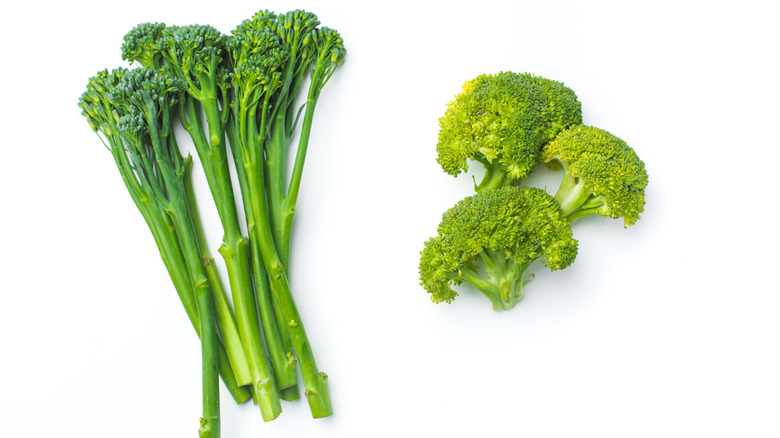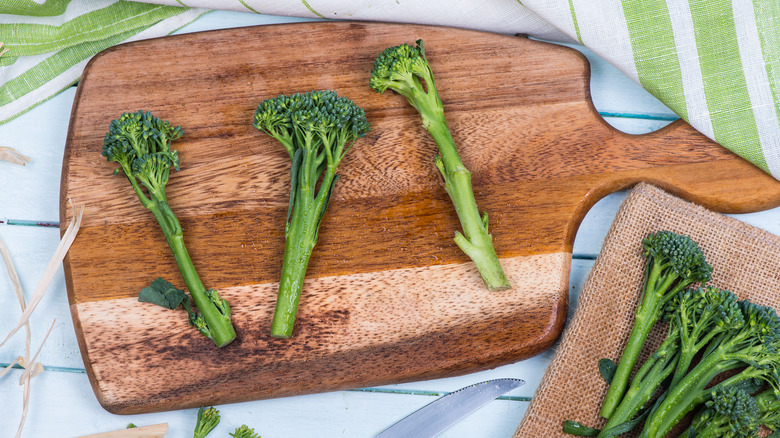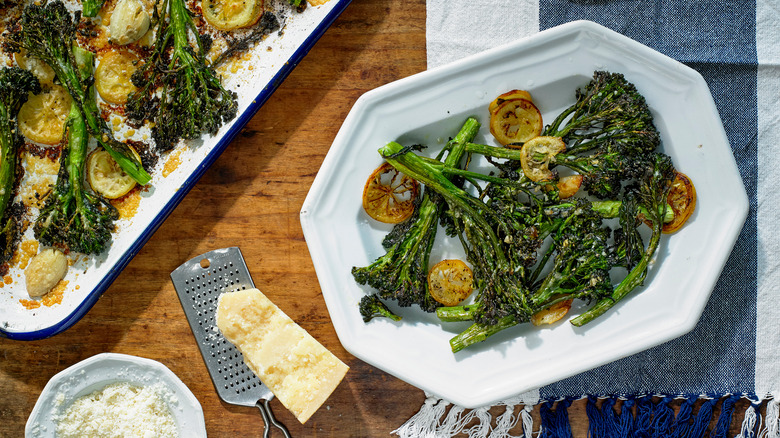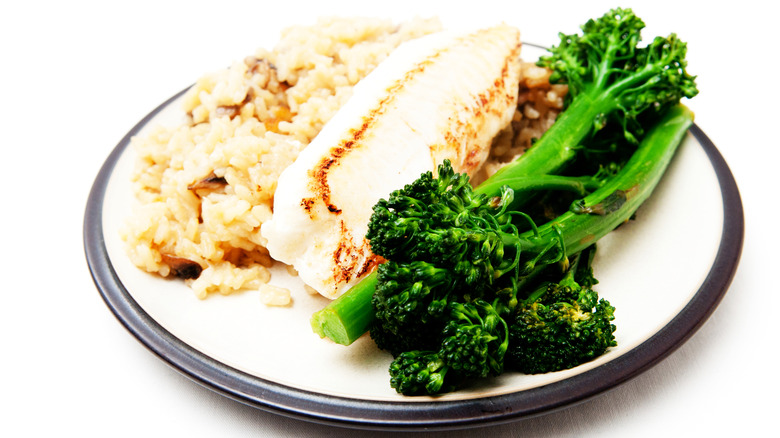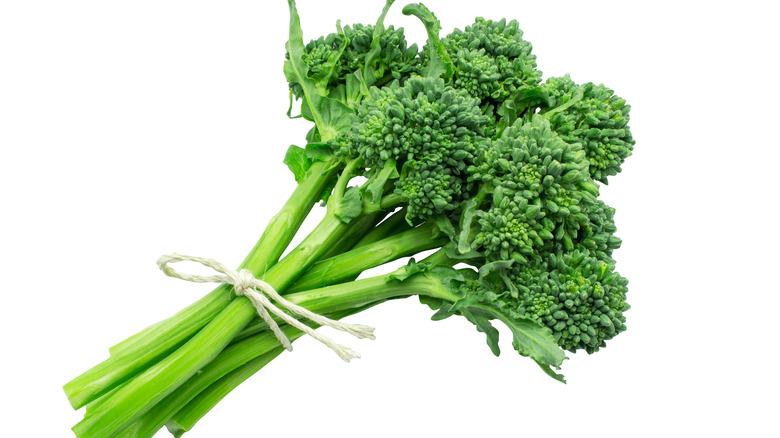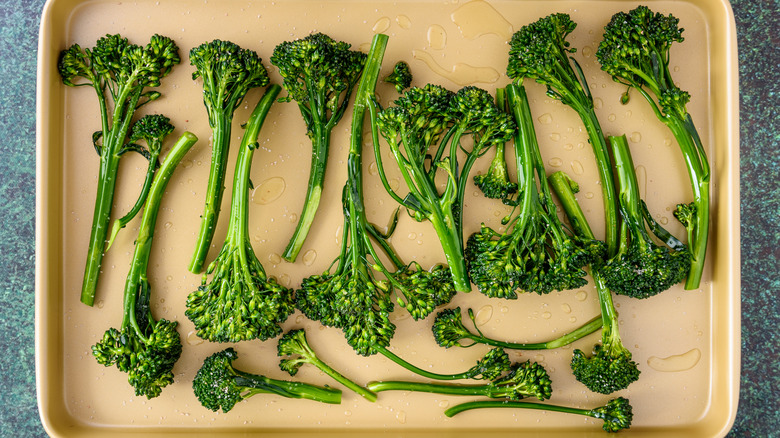Broccolini Vs Broccoli: What's The Difference?
You've probably heard of broccolini or maybe even tasted it, but what exactly is this vegetable, and what makes it different from the more familiar broccoli?
Broccolini is a hybrid of broccoli (Brassica oleracea var. botrytis) and gai lan (Brassica oleracea var. alboglabra), more commonly known as Chinese broccoli, Chinese kale, or "kailaan." Before it was given the broccolini moniker, it was first called broccoli-gai lan (via University of Washington).
Though developed by Japanese scientists, most of the broccolini sold in the United States is grown in California and New Mexico, and it's available all year. It's a favorite vegetable of Food Network star Ina Garten, who has prepared it several ways, including roasting it with panko gremolata or tossing it with garlic and oil.
You might be wondering: where does broccoli rabe fit into all of this? The answer is it doesn't. According to Bon Appetit, broccoli rabe is actually a member of the turnip family. Similarly, broccolini is not the same vegetable as baby broccoli. To learn more about delicious broccolini, read on.
What is broccolini?
Though the petite size of its edible florets and the Italian diminutive "-ini" in the name lead some people to believe broccolini are simply "baby" or immature broccoli, broccolini is actually its own unique vegetable and worth cooking or trying in a restaurant if you haven't already discovered this tasty plant.
Broccolini is the result of crossbreeding broccoli and the leafy vegetable Chinese broccoli (via University of Washington). According to Bon Appetit, the hybridization gave us what we now know as broccolini. Broccolini features small broccoli-like florets. The florets, as well as edible leaves, grow from long stems. These latter features come from broccolini's Chinese broccoli genes.
How did this broccoli-and-gai lan mashup occur? Scientists working for Japan's Sakata Seed Company created the hybrid in 1993, giving it the brand name "aspabroc" to convey to customers its subtle asparagus-like flavor. In 1994, Sakata partnered with Sanbon Inc. to grow the seed variety in Mexico, renaming the variety once again, this time calling it "asparation." In 1996, asparation was introduced to the United States retail market under the more marketable name, broccolini.
Broccolini is sweeter
Appearance is one of the many ways broccoli and broccolini differ. While broccoli's stubby trunk produces a rounded head of tightly clustered florets, broccolini florets grow from the top of narrow 3”-5” stems (via Specialty Produce). What is the flavor difference? It's very noticeable, in fact. Though you can taste both the broccoli and the Chinese broccoli in the hybrid broccolini, broccolini is sweeter than broccoli, which it owes to the gai lan. Specialty Produce says the stems have a crunchy texture and succulent flavor, while the leaves and florets are a "delicate, brittle, and crisp" texture. According to Kitchn, broccolini also tastes "earthier" than broccoli. It also has a subtle asparagus flavor.
Overall, those who have tasted broccolini agree that it is more refined and complex than broccoli. According to Washington State University, broccolini's subtle sweetness is complemented by a distinctive "peppery kick" as well as a subtle mustard undertone. New Mexico chef and restaurant owner Sarah Hartford describes broccolini as "less cabbagey" than broccoli (via New Mexico Farmers' Marketing Association). Washington State adds that while broccolini can be eaten raw, cooking it brings out this vegetable's "fresh, sweet nuances."
"Barefoot Contessa's" Ina Garten says, "It's just delicious" (via Food Network).
Is broccolini more nutritious than broccoli?
From a nutritional standpoint, broccolini should be a part of your regular meal rotation, even though broccoli comes out slightly ahead by some health standards. According to Colorful Plates, broccoli offers more vitamins and minerals, including higher levels of vitamin B12 (essential for keeping blood and nerve cells healthy, via NIH) and folate (essential for cell growth and healthy pregnancies, via NIH).
Broccolini is, however, high in Vitamin A. A 1-cup serving offers 39% of the RDA of this essential vitamin. Broccolini also offers 105% of the RDA of vitamin C. Broccoli fares only slightly better in vitamins A and C, with 48% and 169% of the RDA, respectively. Both broccolini and broccoli contain sulforaphane, a phytochemical that fights skin cancer (via Mindfood).
Broccolini is also great for your digestive system. Its high fiber content acts as a prebiotic by promoting the growth of good bacteria in your digestive tract. This fiber also aids in digestion, promotes regularity, and helps to maintain steady blood sugar levels.
Finally, broccolini helps to cleanse the liver, according to Mindfood. This is because broccolini, like the other members of the brassica plant family, contains the indole 3 carbinol enzyme, which acts as a liver detoxifier and helps the body maintain a healthy hormonal balance.
Broccolini costs a little more
Are you eager to cook up some broccolini at home? Before you hit the produce aisle, you should know that broccolini is going to cost more per ounce than broccoli, but not a lot more (via The Mercury News). The reason for the uptick in price might surprise you: It has to do with the shape and characteristics of the broccoli-Chinese kale hybrid, and how it relates to harvesting. Since a "bunch" of broccoli has two or three stalks, it only takes two or three cuts to harvest. However, because broccolini consists of 15 to 20 stalks similar in size to asparagus, it takes more time to cut and harvest. This increased labor equates to higher costs for growers, which they pass on to stores and consumers.
At the time of writing, a suburban Virginia Safeway store was selling 6 ounces of broccolini for $4.09 (via Instacart). A 10-ounce bag of broccoli florets, however, could be purchased for just 50 cents more.
Which is easier to cook with for common recipes?
Although cutting up a head of broccoli isn't a terribly time-consuming job, broccolini is a little easier when it comes to prep work. Broccolini florets are already bite-sized, so they require no chopping. Broccolini stems are very edible with no cutting or peeling required. And there's no need to de-leaf broccolini, as the leaves are edible and delicious.
According to Kitchn, if you have a recipe that calls for broccoli florets, broccolini florets can be easily substituted.
Ina Garten demonstrates that broccolini can be prepared even more easily than broccoli by sauteeing it. She starts simply by cutting off the last half-inch or so of the stalk. She blanches the broccolini in salted boiling water, puts them in ice water to halt the cooking, and sautees it in butter, lemon zest, and garlic. Garten finishes the dish by adding more salt, pepper, and lemon juice (via Food Network).
According to Love & Olive Oil, broccolini is also a breeze to broil in the oven. Just trim the ends, toss the stalks in olive oil and soy sauce, and broil them on a sheet pan for 15 minutes.
One final note: broccolini is harder to find than the ubiquitous broccoli. However, it is available year-round (via Specialty Produce). If your local supermarkets don't carry it, try specialty produce markets or seasonal farmers' markets.
